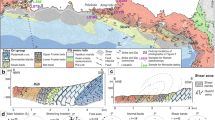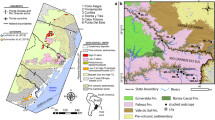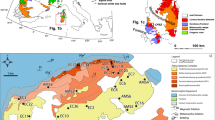Abstract
The serpentinized peridotites overlying the subducted zones in the Izu-Bonin-Mariana (IBM) arc system have been interpret as the cause of the low-velocity layer identified beneath the IBM froearc, in turn few earthquakes occurred along the plate boundary. Chrysotile, which is a low temperature and highly hydrated phase of serpentine with low frictional strength, has been suggested as the low velocity material in the serpentinized peridotites, besides, brucite is inferred to be likely conducive to stable sliding. However, such idea encounters challenging in our serpentinized peridotites from the southern Mariana forearc, which absent both the above minerals. The presence of talc, which characterized by its weak, low-friction and inherently stable sliding behavior, provides new clue. Here we report the occurrence of talc in serpentinized peridotites collected from the landward trench slope of the southern Mariana forearc. We infer that talc is mainly forming as a result of the reaction of serpentine minerals with silica-saturated fluids released from the subducting slab, and talc also occurs as talc veins sometimes. Due to its unique physical properties, talc may therefore play a significant role in aseismic slip in the IBM subduction zone.
Similar content being viewed by others
References
Allen D E, Seyfried W E. 2003. Compositional controls on vent fluids from ultramafichosted hydrothermal systems at mid-ocean ridges: An experimental study at 400°C, 500 bars. Geochim. Cosmochim. Acta, 67: 1 531–1 542.
Andreani M, Escartín J, Hirth G et al. 2006. Deformation mode of talc from subsurface to dehydration conditions: implications for the subducting oceanic lithosphere. Eos Trans. AGU. 87(52), Fall Meet. Suppl., Abstract V31C-0599.
Benton L D, Ryan J G, Tera F. 2004. Boron isotope systematics of slab fluids as inferred from a serpentine seamount, Mariana forearc. Earth Planet. Sci. Lett., 187: 273–282.
Bloomer S H, Fisher R L. 1987. Petrology and geochemistry of igneous rocks from the Tonga Trench-a nonaccreting plate boundary. Journal of Geology, 95: 469–495.
Bebout G E, Barton M D. 2002. Tectonic and metasomatic mixing in a high-T, subduction-zone mélange — insights into the geochemical evolution of the slab-mantle interface. Chem. Geol., 187: 79–106.
Chen J B, Zeng Z G. 2007. Metasomatism of the peridotites from southern Mariana fore-arc: Trace element characteristics of clinopyroxene and amphibole. Science in China (Series D: Earth Sciences), 50(7): 1 005–1 012.
Chernosky J V, Day H W, Caruso L J. 1985. Equilibria in the system MgO-SiO2-H2O: Experimental determination of the stability of Mganthophyllite. Am. Mineral., 70: 223–236.
Caruso L, Chernosky J V. 1979. The stability of lizardite. Canadian Mineralogist, 17: 757–769.
D’Antonio M, Kristensen M B. 2004. Serpentine and brucite of ultramafic clasts from the South Chamorro Seamount (Ocean Drilling Program Leg 195, Site 1200): inferences for the serpentinization of the Mariana forearc mantle. Mineralogical Magazine, 68(6): 887–904.
D’Orazio M, Boschi C, Brunelli D. 2004. Talc-rich hydrothermal rocks from the St. Paul and Conrad fracture zones in the Atlantic Ocean. Eur. J. Mineral, 6: 73–83.
Evans B W. 2004. The serpentinite multisystem revisited: chrysotile is metastable. International Geology Review, 46: 479–506.
Escartín J, Mével C, MacLeod C J et al. 2003. Constraints on deformation conditions and the origin of oceanic detachments: The Mid-Atlantic Ridge core complex at 15°45′N. Geochem. Geophys. Geosyst., 4(8): 1067, doi:10.1029/2002GC000472.
Escartín J, Hirth G, Evans B. 2001. Strength of slightly serpentinized peridotites: implications for the tectonics of oceanic lithosphere. Geology, 29(11): 1 023–1 026.
Escartín J, Andreani M, Hirth G et al. 2008. Relationships between the microstructural evolution and the rheology of talc at elevated pressures and temperatures. Earth and Planetary Science Letters, 268: 463–475.
Fryer P B, Salisbury M H. 2006. Leg 195 synthesis: Site 1200-Serpentinite seamounts of the Izu-Bonin/Mariana convergent plate margin (ODP Leg 125 and 195 drilling results). Proc. ODP, Sci. Results, 195: 1–30.
Fryer P, Becker N, Appelgate B et al. 2003. Why is the Challenger Deep so deep? Earth and Planetary Science Letters, 211: 259–269.
Fryer P. 1996. Evolution of the Mariana Convergent Plate Margin System. Rev. Geophys., 34: 89–125.
Fryer P. 1992. A synthesis of Leg 125 drilling of serpentine seamounts on the Mariana and Izu-Bonin forearcs. Proc. ODP, Sci. Results, 125: 593–614.
Fryer P, Saboda K L, Johnson L E et al. 1990. Conical seamount: SeaMARC II, Alvin submersible, and seismic-reflection studies. Proc. ODP, Sci. Results, 125: 69–80.
Fryer P, Ambos E.L, Hussong D. M. 1985. Origin and emplacement of Mariana forearc seamounts. Geology, 13(11): 774–777.
Fujioka K, Okino K, Kanamatsu T et al. 2002. Morphology and origin of the Challenger Deep in the Southern Mariana Trench. Geophysical Research Letters, 29, doi:10.1029/2001GL013595.
Gvirtzman Z, Stern R J. 2004. Bathymetry of Mariana Trench-arc system and formation of the Challenger Deep as a consequence of weak plate coupling. Tectonics, 23: TC2011. doi: 10.1029/2003TC001581.
Hirauchi K I, Yamaguchi H. 2007. Unique deformation processes involving the recrystallization of chrysotile within serpentinite: implications for aseismic slip events within subduction zones. Terra Nova, 19(6): 454–461.
Ishii T. 1985. Dredged samples from the Ogasawara fore-arc seamount or ‘Ogasawara paleoland’-’Fore-arc ophiolite’. Formation of Active Ocean Margins. Terra Scientific Publishing Company, Tokyo, pp. 307–342.
Iyer K, Austrheim H, John T et al. 2008. Serpentinization of the oceanic lithosphere and some geochemical consequences: Constraints from the Leka Ophiolite Complex, Norway. Chemical Geology, 249: 66–90.
Jenkins D M, Holland T J B, Clare A K. 1991. Experimental determination of the pressure-temperature stability field and thermochemical properties of synthetic tremolite. Am. Mineral, 76: 458–469.
Kamimura A, Kasahara J, Shinohara M et al. 2002. Crustal structure study at the Izu-Bonin subduction zone around 31°N: implications of serpentinized materials along the subduction plate boundary. Phys. Earth Planet. Inter., 132: 105–129. doi:10.1016/S0031-9201(02)00047-X.
Manning C E. 1995. Phase-equilibrium controls on SiO2 metasomatism by aqueous fluid in subduction zones: Reaction at constant pressure and temperature. Int. Geol. Rev., 37: 1 039–1 073.
Mével G. 2003. Serpentinization of abyssal peridotites at mid-ocean ridges. Geoscience, 335: 825–852.
Michibayashi K, Tasaka M, Ohara Y et a1. 2007. Variable microstructure of peridotite samples from the southern Mariana Trench: Evidence of a complex tectonic evolution. Tectonophysics, 444(1–4): 111–118.
Moore D E, Lockner D A. 2008. Talc friction in the temperature range 25°C–400°C: Relevance for fault-zone weakening. Tectonophysics, 449: 120–132.
Moore D E, Michael J R. 2007.Talc-bearing serpentinite and the creeping section of the San Andreas fault. Nature, 448: 795–797.
Moore D E, Lockner D A. 2007. Comparative deformation behavior of minerals in serpentinized ultramafic rock: Application to the slab-mantle interface in subduction zones. Int. Geol. Rev., 49: 401–415.
Moore D E, Lockner D A, Ma S et al. 1997. Strengths of serpentinite gouges at elevated temperatures. J. Geophys. Res., 102: 14, 787–14,801.
Moore D E, Lockner D A, Summers R et al. 1996. Strength of chrysotile-serpentinite gouge under hydrothermal conditions: can it explain a weak San Andreas fault? Geology, 24: 1 041–1 044.
Mottl M J, Komor S C, Fryer P et al. 2003. Deep-slab fluids fuel extremophilic Archaea on a Mariana forearc serpentinite mud volcano: Ocean Drilling Program Leg 195. Geochem., Geophys., Geosyst., 4. doi:10.1029/2003GC000588.
Natland J H, Tarney J. 1982. Petrologic evolution of the Mariana arc and back-arc basin system: a synthesis of drilling results in the south Philippine Sea. Initial Reports of the Deep Sea Drilling Project, 60: 877–908.
Ohara Y, Ishii T. 1998. Peridotites from the southern Mariana forearc: Heterogeneous fluid supply in mantle wedge. The Island Arc, 7(3): 541–558.
O’Hanley D S. 1996. Serpentinites: Records of Tectonic and Petrological History. Oxford Monographs on Geology and Geophysics, 34, Oxford University Press.
O’Hanley D S, Wicks F J. 1995. Conditions of formation of lizardite, chrysotile and antigorite, Cassiar, British Columbia. Canadian Mineralogist, 33: 753–773.
Parkinson I J, Pearce J A, Thirlwall M F et al. 1992. Trace element geochemistry of peridotites from the Izu-Bonin-Mariana forearc, Leg 125. Proc. ODP, Sci. Results, 125: 487–506, doi:10.2973/odp.proc.sr.125.183.1992.
Pawley A R, Wood B J. 1995. The high-pressure stability of talc and 10 Å phase: potential storage sites for H2O in subduction zones. Am. Mineral, 80: 998–1003.
Peacock S M, Hyndman R D. 1999. Hydrous minerals in the mantle wedge and the maximum depth of subduction thrust earthquakes. Geophys. Res. Lett., 26: 2 517–2 520, doi:10.1029/1999GL900558.
Peacock S M. 1987. Serpentinization and infiltration metasomatism in the Trinity peridotite, Klamath province, northern California: implications for subduction zones. Contrib. Mineral. Petrol., 95: 55–70.
Phipps S P, Ballotti D. 1990. Rheology of serpentine muds in the Mariana-Izu-Bonin forearc. Proc. ODP, Sci. Results, 125: 363–372.
Reinen L A. 2000. Seismic and aseismic slip indicators in serpentinite gouge. Geology, 28: 135–138.
Sato T, Ishimura C, Kasahara J et al. 2004. The seismicity and structure of Izu-Bonin arc mantle wedge at 31°N revealed by ocean bottom seismographic observation. Physics of the Earth and Planetary Interiors, 146(3–4): 551–562, doi:10.1016/j.pepi.2004.06.003.
Schroeder T, John B E. 2004. Strain localization on an oceanic detachment fault system, Atlantis Massif, 30°N, Mid-Atlantic Ridge. Geochem. Geophys. Geosyst., 5: Q11007, doi:10.1029/2004GC000728.
Stern R J, Fouch M J, Klemperer S L. 2004. An overview of the Izu-Bonin-Mariana subduction factory. In: Eiler J. eds. Inside the Subduction Factory, Washington, DC: American Geophysical Union, 138: 175–223.
Taira A, Tokuyama H, Suyehiro K et al. 1998. Nature and growth rate of the northern Izu-Bonin (Ogasawara) arc crust and their implications for continental crust formation. The Island Arc, 7: 395–407. doi:10.1111/j.1440-1738.1998.00198.x.
Takahashi N, Suyehiro K, Shinohara M. 1998. Implications from the seismic crustal structure of the northern Izu-Bonin arc. The Island Arc, 7: 383–394.
Seno T. 2005. Variation of downdip limit of the seismogenic zone near the Japanese islands: Implications for the serpentinization mechanism of the forearc mantle wedge. Earth and Planetary Science Letters, 231: 249–262.
Author information
Authors and Affiliations
Corresponding author
Additional information
Supported by the Pilot Project of Knowledge Innovation Project, Chinese Academy of Sciences (No. KZCX2-YW-211, KZCX3-SW-223), the National Natural Science Foundation of China (No. 40830849), and the Special Foundation for the Eleventh Five Plan of COMRA (No. DYXM-115-02-1-03)
Rights and permissions
About this article
Cite this article
Wang, X., Zeng, Z., Liu, C. et al. Talc-bearing serpentinized peridotites from the southern Mariana forearc: implications for aseismic character within subduction zones. Chin. J. Ocean. Limnol. 27, 667–673 (2009). https://doi.org/10.1007/s00343-009-9207-y
Received:
Accepted:
Published:
Issue Date:
DOI: https://doi.org/10.1007/s00343-009-9207-y




